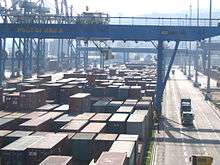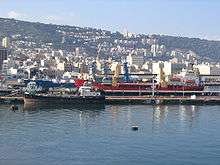Port of Haifa
| Port of Haifa נמל חיפה | |
|---|---|
|
The Port of Haifa | |
| Location | |
| Country |
|
| Location | Haifa |
| Coordinates | 32°49′12″N 35°00′16″E / 32.820118°N 35.00448°E |
| Details | |
| Opened | 1933 |
| Operated by | Israel Port Authority |
| Owned by | Government of Israel |
| Statistics | |
| Annual container volume | 1.36 million TEU (2013) |
| Passenger traffic | 253,524 (2013) |
|
Website haifaport.co.il | |
The Port of Haifa (Hebrew: נמל חיפה) is the largest of Israel's three major international seaports, which include the Port of Ashdod, and the Port of Eilat. It has a natural deep water harbor which operates all year long, and serves both passenger and merchant ships. It is one of the largest ports in the eastern Mediterranean in terms of freight volume and handles about 26 million tons of cargo a year. The port employs over 1,000 people, with the number rising to 5,000 when cruise ships dock in Haifa.[1] The Port of Haifa lies to the north of Haifa's downtown quarter on the Mediterranean, and stretches to some 3 kilometers along the city's central shore with activities ranging from military, industrial and commercial next to a nowadays-smaller passenger cruising facility.
History

Haifa Bay has been a refuge for mariners since prehistoric times. When the Crusaders conquered Haifa in the year 1100, it became an important town and the main port for Tiberias, the capital of the Galilee. The port fell into disrepair during the Mamluk reign, and acquired the reputation of a pirate lair in the 18th century.
Until the beginning of the 20th century, Acre served as the main port for the region. However, the port eventually became clogged with silt, and was unable to accommodate large ships. The first person to comprehend the tremendous possibilities of a port in Haifa was Theodor Herzl, the father of Political Zionism, who in 1902 wrote a prophetic description of the town in his book AltNeuland. Construction of the port began in 1922, and it was officially opened on October 31, 1933 by Lieut. Gen. Sir Arthur Wauchope, the British High Commissioner for Palestine. [2] The port allowed Haifa to blossom, and in 1936, the city had over 100,000 inhabitants. The port was a gateway for thousands of immigrants to Israel after the Second World War.[3] With Israel’s western borders the Mediterranean and the eastern borders sealed by its Arab neighbors, Haifa served as a crucial gateway to the rest of the world, and helped Israel develop into an economic power. Today the port brings both passenger and cargo traffic to a bustling metropolis, much as Theodor Herzl predicted over a century ago.
The port has been the scene of two fatal sinkings. The Patria disaster in 1940 killed 267 people; the loss of Shelly in 2007 killed two.
Facilities

The Port of Haifa contains many cargo terminals, and is capable of servicing many ships at once. A railroad freight terminal is inside the port and is used for transporting goods across the country. The port also features a passenger terminal, fishing wharf, yacht club, sports marina, and chemical terminal. In 2013, the port processed about 26 million tons of cargo including 1.36 million TEUs, as well as 253,524 passengers. The port opened the first phase in the "Carmel Port" expansion program in 2010 that involved the construction of a new cargo terminal which includes a 700m long wharf capable of handling 9,200 TEU container ships (of up to 15.5 metres (51 ft) draft) as well as the opening of a secondary 250 metres (820 ft) wharf plus adjacent support and storage areas. The new facilities will expand the port's annual container handling capacity by 500,000 TEU. Construction of this new terminal cost NIS1.8 billion (appx. US$500 million) and took five years to complete.[4]
The Port maintains facilities for the United States Sixth Fleet.[5]
On 4 January 2013, the MSC Chicago docked at the port's Carmel terminal, making it the largest container ship ever to visit Haifa. MSC Chicago has a capacity of 9,200 containers. The previous record ship visit was the MSC Maeva (capacity of 8040 containers) which had visited two months before.[6]
Israel Shipyards is nearby the port and provides heavy ship repair facilities. The company also operates a private port on its premises which in 2013 handled approximately 1.7 million tons of cargo.
Passenger terminal
The port contains a modern passenger terminal serving cruise and ferry passengers. The terminal offers a waiting area, duty-free shop, souvenir shop, cafeteria, VAT reimbursement counter, currency exchange, free wireless internet, parking, as well as other services to travelers.[7]
The area near the terminal also offers excellent public transit connections for passengers. The Haifa Center Railway Station is adjacent to the terminal and is served by nearly 200 passenger trains 24 hours a day on weekdays to the Haifa region and beyond. Additional public transit connections are available by bus or taxi at the railway station or on Ha'Azmaut Road, the main thoroughfare in downtown Haifa which is located in front of the station. The Carmelit's Kikar Paris subway station is also within walking distance and allows convenient access to the top of Mount Carmel.
Expansion
As of 2012, the Israel Port Authority is in the design and permitting stage for a major expansion of the port at a cost of NIS 4 billion (approximately US$1.1 billion). The plan involves the following:[8]
- Extensive reclamation of an area northeast of the mouth of Kishon River which will enable the construction of a large new terminal to be named the "Bay Terminal" that will be capable of handling giant container ships carrying more than 15,000 TEUs each.
- Extension of the main breakwater by 880m and construction of a new secondary breakwater.
- An expansion of the existing Carmel terminal.
- A new fuels terminal, replacing the existing one which dates back to the 1940s.
- Expansion of the existing chemicals terminal.
The new terminal may be inaugurated as early as 2018, at which point the existing container terminals at Haifa and Ashdod are expected to reach their maximum handling capacity.
See also
- Gilla Gerzon (Information on Haifa USO)
References
- ↑ Blau, Uri (2007-06-28). "Radius of destruction". Haaretz.
- ↑ "Troops on Guard as Britain Opens Harbor of Haifa". Chicago Daily Tribune. 1933-11-01. p. 24. Retrieved 2007-08-24.
- ↑ Samuels, Gertrude (1949-08-21). "From Munich to Haifa: Journey Into the Light; For present-day Israeli immigrants, the trip is a dawn of hope after many years of dark tragedy". The New York Times. Retrieved 2007-08-24.
- ↑ Port2Port.co.il: History made at the Port of Haifa - Carmel wharf opens (in Hebrew).
- ↑ [encarta.msn.com/encyclopedia_761575544/Haifa.html Haifa] on Encarta
- ↑ Wolfson, Ofer (2013-01-04). "נמל חיפה שבר שיא עם MSC CHICAGO" [Port of Haifa breaks record with MSC CHICAGO] (in Hebrew). News1. Retrieved 2013-01-06.
- ↑ "Tourist Gateway". Port of Haifa. Retrieved 2014-06-14.
- ↑ "המועצה הארצית לתכנון ולבניה אישרה להפקדה את תוכניתה של חברת נמלי ישראל להקמת "נמל המפרץ [National Planning and Construction Commission Approves Consideration of the "Bay Terminal" Plan] (Press release) (in Hebrew). Israel Port Authority. 2012-12-12. Retrieved 2013-01-07.
External links
| Wikimedia Commons has media related to Port of Haifa. |
